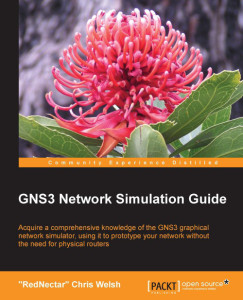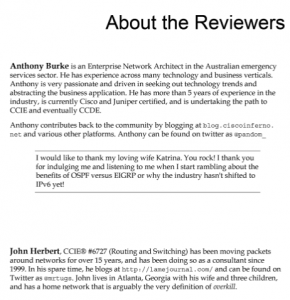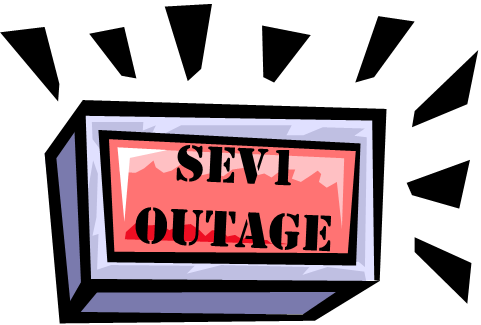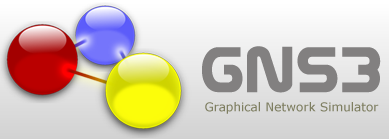 It seems it would be rude not to take a moment to give a plug to this new book, the GNS3 Network Simulation Guide that has just been published, written by Chris Welsh (@rednectarchris on Twitter).
It seems it would be rude not to take a moment to give a plug to this new book, the GNS3 Network Simulation Guide that has just been published, written by Chris Welsh (@rednectarchris on Twitter).
GNS3 makes building and simulating networks so simple that most of us don’t think we need to bother reading the help files, but in fact it has an awful lof of functionality and a large number of quirks that just aren’t obvious without them being pointed out. It reminds me a little bit of the way Apple does things. For example, the iPhone’s iOS Calculator app is a regular dumb calculator, unless you think to turn the phone into landscape orientation at which point it transforms into a scientific calculator. There’s no hint that this capability exists; you either find it by mistake or somebody gives you a tip. Sometimes we need hints and tips to get the most out of what we have, no matter how intuitively obvious they seem to be.
The book is a little more than that, though.
GNS3 Network Simulation Guide
I’m reasonably confident using GNS3, but from the first chapter of Chris’ book, I found that I was learning some of those tips and tricks that I hadn’t known before. It isn’t that I couldn’t get the same end result, it’s just that there are shortcuts that would have made my life easier if I had only discovered them!
The book looks at hooking in the Virtual PC Simulator (VCPS) to generate basic IP traffic across the simulated network (how many of us have used another router as an IP endpoint for testing rather than figure out the admittedly rather arcane VCPS configuration?). The book covers this pretty well, and while I maintain that the way it’s done by GNS3 itself could be so much more friendly, you can’t argue with having a guide to doing it.
Chris goes on to look at multi-computer simulations (all but essential once you begin to scale your simulations), and explains a lot about how the systems communicate under the hood, so to speak. There is a LOT of information in this book. Some of it’s good for reading through, and some is best as a reference to look at when needed, but however you use it I felt that I had learned a pretty decent amount about GNS3, a tool that I use and know reasonably well already. I think that’s a win.
Look at the full chapter list online to see the wider scope of the book – there’s more than I’m able to mention here.
So, if you’re interested in the book, it’s available from the publisher PACKT, Amazon, and also Barnes and Noble and Safari Books Online (these are not affiliate links). The eBook edition is well priced, I think.
Disclaimer
As always, I want to be clear about my relationship to what I write about. In this case I was one of the two technical reviewers for this book (excerpt from Amazon book preview):
I was compensated a small amount in kind for my efforts, but I have not been asked to, nor do I benefit from, mentioning the book. I sure don’t get any “back end” from sales, so talking about this is purely a good will gesture on my part, not least because I think the book has some good information in it that others may enjoy. I recommend that if you’re interested, you check out the preview chapters and see what you think.





Leave a Reply